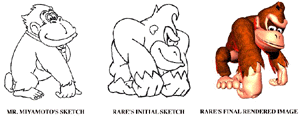Donkey Kong Country Rare Retrospective


Donkey Kong Country was the beginning of a new era for Rare, and the game which was to haul the company back into the limelight after years of quiet work on less conspicuous titles. It was the product of many arrangements and discoveries coming together: Nintendo’s agreements with Silicon Graphics (creators of the machines that generated effects for films such as T2, Jurassic Park and Forrest Gump) and Alias Research (publishers of some of the most powerful rendering software in the world) paved the way for a new standard of graphic excellence, a potential which could be fully exploited amidst the proprietary development systems of Rare itself.
The result was ACM, Advanced Computer Modelling, a method of creating and animating every pixel of every graphic in a total computer environment, incorporating any stages previously performed outside the immediate hardware. It was a revelation for the games industry, the next step on from digitisation, combining new levels of photo-realistic detail and light sourcing with state-of-the-art motion capture techniques for some stunning results. And once the main problem of compressing these visuals into 16-bit had been tackled, DKC emerged as the product that pushed the humble SNES further than anyone had thought possible.


By 4pm of the following day it had brought in £1,000,000, outstripping all other titles. It topped the Christmas sales charts in America and Japan, and to date has sold over 8 million copies on the SNES alone. The successful conversion of ACM graphics to the Game Boy caused another great stir in the market, further disproving claims that 8 and 16-bit machines had reached the end of the line, and sequels on both Game Boy and SNES have helped prolong both formats’ second wind right up to this day.
